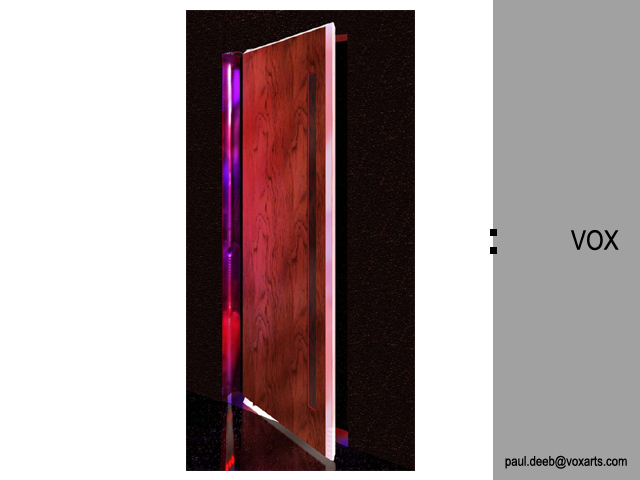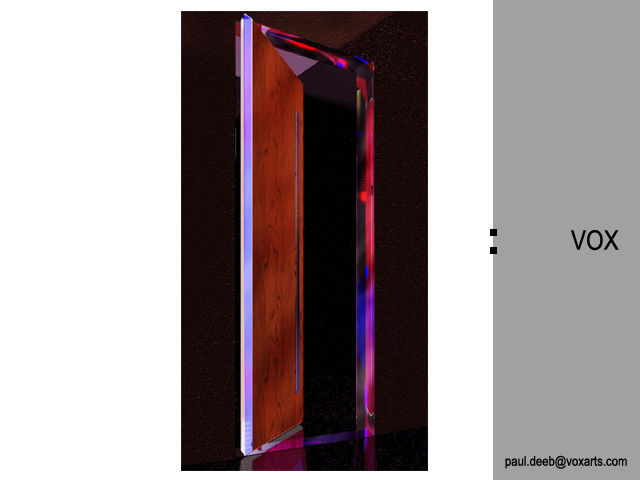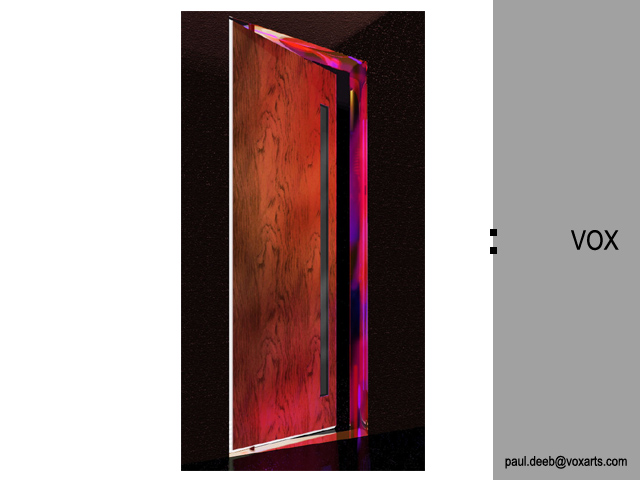
sonus lumina portal by paul deeb from usa
designer's own words:
" SONUS LUMINA PORTAL "
The design has three components:
a)light emitting, transmitting
b)light reflection, refraction
c)pitch or harmony dispersing
The design has the following construction characteristics:
The door is of a swing type configuration, no latch is necessary. Swinging mechanism to function in either direction with a spring loaded or tensioned return to center. The door's swing axis is inset
to approximately one fifth of overall width from the door edge.
The door's "body" is constructed of wood over metal frame. The interior space of this enclosure is an acoustical cavity, the frame is fitted with one or more piano strings of lengths corresponding to
desired pitch, intervals or chords and a striking mechanism which operates with the door's natural motion and inertia. A vertical opening of approximately 2" width X 54" height with a grille of
either acoustically transparent fabric or perforated metal comprises the cavity's "sound hole". This aperture provides service and tuning access for the sound producing mechanism. The door's edges are equilateral non-silvered glass prisms, the
corner sections where the prisms meet form compound prisms or achromats. L.E.D. strip lighting is located beneath the prism edges, installed in the door's frame. A small motion sensor mounted in the wall proximate to the door switches the lighting upon approach from either, or both sides of the portal ( for dual operation one sensor with a bi-directional lens or two discreet sensors could be used. The door could also be configured to react to other stimuli; temperature, time or input from remote sensors e.g.
The door frame houses three half-round reflectors, located on the top, left side and right side of the frame facing the door edges. The reflectors are made from Alanod reflective aluminum ( type miro
27 ) and cover the width and height of the door opening. The door threshold is similarly fitted with a reflector, albeit not a concave one. The door's axis is a stationary, hollow stainless steel tube through which all necessary electrical wiring passes. The door itself rotates on bearings fitted to this shaft. The shaft penetrates both top and bottom prisms as well as the top half-spherical and
threshold reflectors. Anchor points are in the actual frame material located behind the reflective surfaces.
The design will function in the following way:
When not in use, sunlight and ambient room lighting will be refracted by the doors prism system and transmitted by the reflective elements of the door frame causing the door's perimeter to issue a luminous glow. Upon approach the in-wall motion sensor will activate the door's lighting system. As the door is swung the harmonic mechanism will issue the doors musical tones, these tones will vary in intensity according to the amount of force exerted upon the door, they would also likely respond to knocking or other gentle motions.
The lighting effect will follow the doors entire path of motion.
The light output will be refracted at angles into and out of the room first by the prism mechanism, as this refracted light moves over the width of the concave reflector mechanism the angle of incidence to the half-round reflector will change causing a second path of reflections to reach into and out of the room at multiple angles.
As the reflector design is rounded, these compound reflections will produce patterns of light and color up to the point at which the door reaches a position perpendicular to the frame. Upon reaching this
limit of travel the light elements will then be fully within the entered room's boundaries, thereby lighting the entered space with a soft glow. As the door motion reverses, so would the patterns of
light until the door returns to rest in it's centered position.
Position-1
 position-2
position-2
 position-3
position-3